
As wild fisheries stagnate and the demand for aquatic products grows, fish farming is expected to play an important role in meeting global demand.
With 12 percent of the planet’s fresh water resources, over 3.5 million hectares of man-made lakes, and a coastline equivalent to the size of the Amazon rainforest, Brazil is well positioned for aquaculture production.
The federal government has implemented a plan for privatizing water resources that can then be used by private companies for fish farming, and its objective is to produce 20 million tons of fish annually through aquaculture.
Privatizing the water in this way enables companies to intensively produce one type of fish in an area, without the fish having to compete with other species for food and space. Raising fish through aquaculture, however, requires the use of countless chemicals and has led to the displacement of small-scale fishermen and women.
“The process of partitioning fresh and salt water taking place across Brazil is similar to the process of exploitation of the land. The land was concentrated in the hands of a few landowners and the small-scale producers were forced out.”
The growth rate for commercial fish production has accelerated. From 2010 to 2013, it doubled, going from 480,000 tons to at least 1 million tons, according to data from the Brazilian Ministry of Fisheries and Agriculture (MPA). For 2014, the expectation is that aquatic production on a national scale will reach 1.3 million tons.
The government’s objective – converting fresh-water aquifers into fish farms – is seen by a group called the Movement of Small-scale Fishermen and Women as a threat to traditional fishing zones. “The process of partitioning fresh and salt water taking place across Brazil is similar to the process of exploitation of the land. The land was concentrated in the hands of a few landowners and the small-scale producers were forced out,” explained María das Neves to Truthout. Das Neves is a fisherwoman in the state of Pernambuco and a member of the movement. “We are also being pushed out to make way for the companies, and it’s not going to be long until this is converted into big water estates.”
Aquaculture systems are being set up across huge areas, eliminating small-scale fishing. Security personnel are contracted to guarantee that the fishermen and women can’t get closer than 50 meters to where the fish are kept. “In addition, these projects affect the ability of fish to lay their eggs and contaminate the water with the medicine they require. [This is done] without taking into account how this will affect everything else in the food chain of the native fish,” María José Pacheco tells Truthout. She is the executive secretary of the Pastoral Fishermen and Women’s Commission (CPP).
Severino Santos, executive secretary of the CPP of the Northeast region, tells Truthout that the fishing sector must be better organized to lessen the impact on small-scale fishing. To do this, he proposes improved species identification and the reorganization of fishing areas, taking into consideration the knowledge of traditional fishermen.
Invisible?
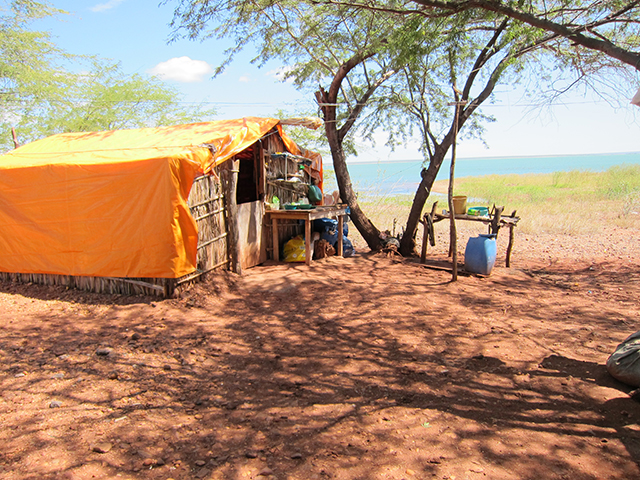 Ranch on an island of Lake Itaparica is used by fishermen to rest. (Photo: Renata Bessi)
Ranch on an island of Lake Itaparica is used by fishermen to rest. (Photo: Renata Bessi)
The Ministry of Fisheries and Agriculture, in an e-mail from its press department, stated that the public policies regarding the development of aquaculture do not compromise those that promote small-scale fishing. “One is not opposed to the other, since they are different in nature, and they both contribute to the objective of increasing the production and quality of fish in this country, both through aquaculture as well as through small-scale fishing.”
The ministry also tries to incentivize small-scale fishermen. For small-scale fisherman, unemployment is guaranteed during the period while fish are laying their eggs (from November to February). Since it is prohibited for them to fish during that period, they are given a credit equivalent to US $970. Severino Santos, however, argues that the Ministry of Fisheries and Agriculture’s actions only highlight the invisibility of small-scale fishing.
Statistical Contradictions
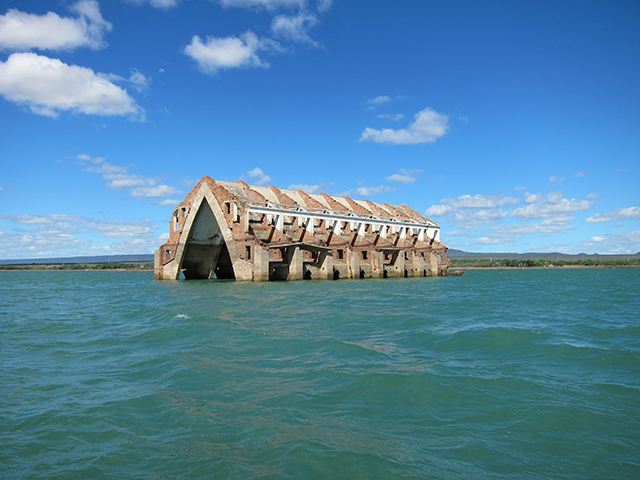 A church submerged for the construction of Lake Itaparica appears due to drought in the Brazilian backlands. (Photo: Renata Bessi)
A church submerged for the construction of Lake Itaparica appears due to drought in the Brazilian backlands. (Photo: Renata Bessi)
Currently, there are 970,000 fishermen and women registered with the MPA ministry, of which 957,000 are small-scale fishermen. According to the ministry, 45 percent of fish produced in the country, 1.24 million tons, come from small-scale fishing.
“There is a certain inconsistency in the data. How is it possible that 96 percent of the fishermen fish less than half of the fish?” Tarciso Quinamo tells Truthout. He is a researcher for the Joaquim Nabucco Foundation (Fundaj). The MPP estimates that 70 percent of fish come from small-scale fishing.
Dubious Quality
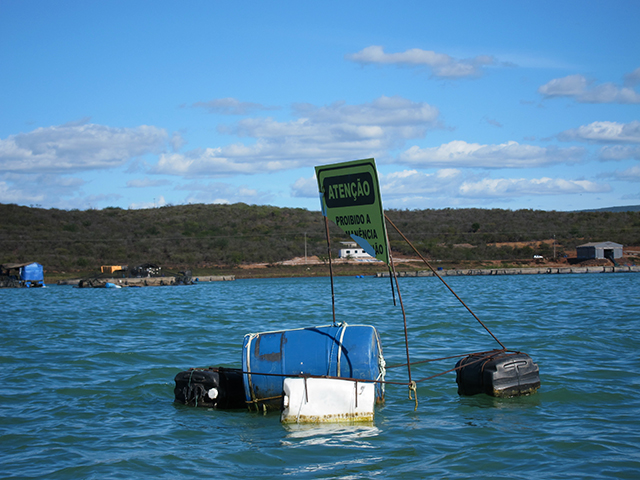 Small-scale fishermen have limited access to the water in areas where there is a growing presence of aquaculture companies. (Photo: Renata Bessi)
Small-scale fishermen have limited access to the water in areas where there is a growing presence of aquaculture companies. (Photo: Renata Bessi)
Lake Itaparica, in northeast Brazil, holds the water of the San Francisco River and is the country’s third-largest body of water, with an area of 834 square kilometers. The lake borders five municipalities in the state of Pernambuco – Floresta, Belén San Francisco, Petrolandia, Itacuruba – and in the state of Bahía, the municipalities of Glória, Chorrochó, and Rodelas. The dam was built for hydroelectric purposes and has been in use since 1988. The cities of Petrolandia, Itacuruba, Rodelas and Barra do Tarrachil were flooded for its construction.
“We know that they develop numerous illnesses that attack animals, like fungi and larvae. We have even seen live fish with half of their body rotted off.”
The Association of Fishermen and Women of Lake Papagaio and the San Francisco Agriculture and Fisheries Association maintain their fish farms on one of the islands of Lake Itaparica, in a region the fishermen know as Serra do Papagaio. There is no way to reach the island’s shore without submerging at least half of one’s body in the water, which looks clean and clear. The Truthout team disembarked a few meters away from the tanks where the fish are raised.
A member of the Fishing Community of Petrolandia, Pedro de Souza, informed Truthout about the complaints that fishermen have raised with regard to the fish that are raised in captivity. “We know that they develop numerous illnesses that attack animals, like fungi and larvae. We have even seen live fish with half of their body rotted off,” he says.
María José, a fish farmer who works on the island, tells Truthout that her activities are basically to feed the fish and to remove the dead fish from the tanks. “Sometimes some swell up as if they were going to explode. Others lose their scales,” she says. To combat the illnesses, the farmers use an onslaught of antibiotics, pesticides and antifungal medications, which are highly toxic and contaminate the water. Nelson de Souza, another worker in the cooperative, tells Truthout that the dead fish have become a problem. “We can’t leave them in the water, because they contaminate it. So the only option is to bury the fish,” he says.
While on Lake Itaparica, the team found containers full of residue made up of fish remains. “A product is used to break down the fish. Not a vulture, not even a fly gets close to these remains,” says Peter.
Asked by Truthout about the sanitary control of the activities, the secretary of economic development and tourism for the municipality of Petrolandia, Marcos Rogerio Viana, says that agronomists from the municipality monitor the farms every 60 days, and there has never been a problem with regard to the quality of the water or the fish.
The Blue Revolution
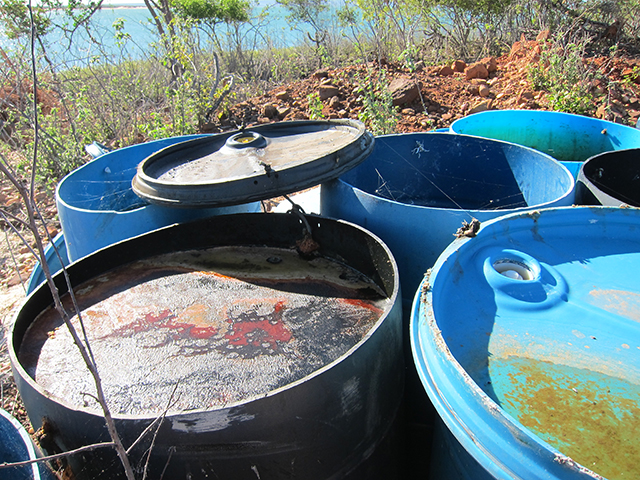 On one of the islands in the lake are containers with traces of fish dissolved with some chemical. (Photo: Renata Bessi)
On one of the islands in the lake are containers with traces of fish dissolved with some chemical. (Photo: Renata Bessi)
The concept of the “Blue Revolution” began in India. The name alludes to the Green Revolution, which was the transition to large-scale agricultural production through mechanization and the use of chemical fertilizers and pesticides. The “Blue Revolution” is the result of a similar approach, but with the objective of dramatically increasing fish production through aquaculture.
According to the FAO, this new system of production would alleviate poverty, generate employment, and function as a response to food security issues. This type of large economic growth project is known by the FAO as Blue Growth, which is described in the document adopted at the UN’s sustainable development conference (Rio+20) in 2012, “The Future We Want.”
The mobility that traditional fishing requires contrasts with the dynamic of the “owners” of the land, who have materialized without prior planning along the lake.
In the year 2012, according to the FAO, the production of fish worldwide reached a level of 158 million tons, and 15 countries produced 92.7 percent of the entire edible fish production. Among them, Chile and Egypt produced millions of tons. Brazil is considered a country with production potential according to global aquaculture classifications. However, according to the FAO data, global fish imports, which grew 108 percent since 2012, were heading principally to the United States, Germany, Japan and France. The FAO projects that by the year 2030 Brazil will be able to contribute by producing 20 million tons of fish annually.
Disputed Aquatic Borders
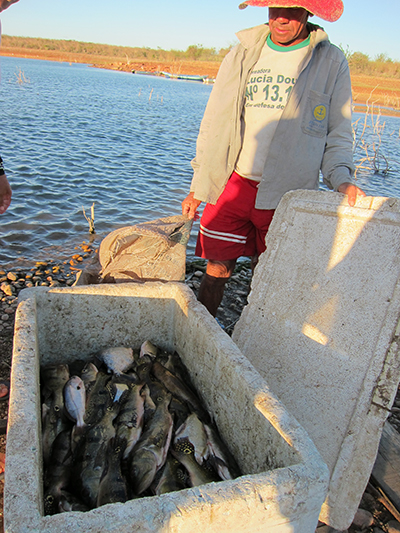 Fishermen arrive at “the ranch” to clean the fish they’ve caught and put them on ice. (Photo: Renata Bessi)The dispute over the shores of Lake Itaparica is another factor that threatens small-scale fishing in the region. The fishermen have been living with the new paraphernalia constructed across the landscape of rare scenic beauty in the semi-arid northeast region of Brazil. On the beaches of the freshwater lake, on its islands, and on the land that borders the lake, walls, fences, posts, cables and signs have been constructed, and they prohibit passage in and outside of the water.
Fishermen arrive at “the ranch” to clean the fish they’ve caught and put them on ice. (Photo: Renata Bessi)The dispute over the shores of Lake Itaparica is another factor that threatens small-scale fishing in the region. The fishermen have been living with the new paraphernalia constructed across the landscape of rare scenic beauty in the semi-arid northeast region of Brazil. On the beaches of the freshwater lake, on its islands, and on the land that borders the lake, walls, fences, posts, cables and signs have been constructed, and they prohibit passage in and outside of the water.
The mobility that traditional fishing requires contrasts with the dynamic of the “owners” of the land, who have materialized without prior planning along the lake.
The fishermen and women have lived with these violent practices not just in terms of physical barriers, but with another form of violence that has broken their customs. Like the destruction of the places that they call “ranches,” where they camp, prepare their nets, have fires, talk, eat and sleep after cleaning and preparing the fish caught during the day. “There is a tree there where we used to camp on the ranch, and when we left, they set it on fire so that we wouldn’t come back. It’s incredible; they cut down the tree so that we wouldn’t go back,” Gilda Henry, a fisherwoman from Itaparica tells Truthout.
Small-scale fishing has its own dynamic. The fisher moves along with the fish, so areas of activity vary. “The fish move away, and we have to go to the other side of the lake to follow them and that’s how we go from ranch to ranch after our fish,” says Gilda. The fishers tend to sleep for days or even weeks on the “ranches” on the shore of the river and on the large islands that make up the Itaparica dam. At the ranches, the fishermen and women live together and exchange experiences and knowledge.
The mobility that traditional fishing requires contrasts with the dynamic of the “owners” of the land, who have materialized without prior planning along the lake. The shore is used for multiple purposes – fish farming, planting and raising animals, as well as for aquatic tourism, summer houses and bars.
Traveling across the dam, one can find fences under the water. “If you come here with your boat to fish on the shores of the lake, quickly the ‘land owner’ will show up and tell you that he doesn’t want anyone here. Some resist and stay, although many times they are afraid that someone will come at night to kill them. And that’s how we became enclosed by these fences,” a local fishermen, José Ilton, tells Truthout.
Who is Responsible for the Land?
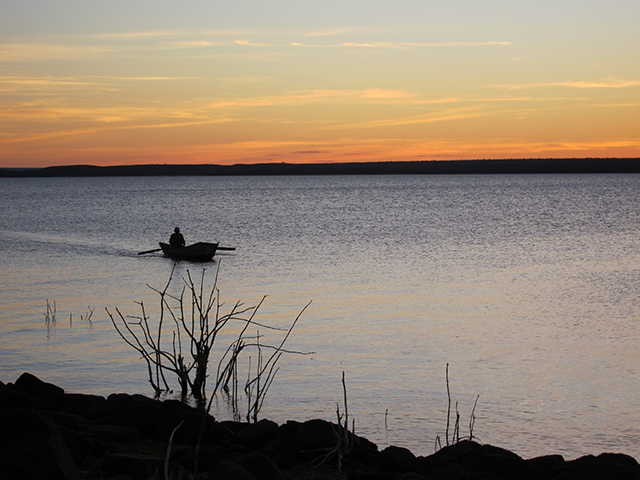 A fisherman returns in the evening to one of the islands in the lake for dinner and sleep after casting nets into the waters to be collected in the morning. (Photo: Renata Bessi)
A fisherman returns in the evening to one of the islands in the lake for dinner and sleep after casting nets into the waters to be collected in the morning. (Photo: Renata Bessi)
The land along the lake is under the administration of the principal hydroelectric energy company in Brazil, The San Francisco Hydroelectric Company (CHESF), which has close ties to the Ministry of Mining and Energy. The Secretary of Economic Development and Tourism of the municipality of Petrolandia, Marcos Rogerio Viana, admits that there are conflicts in the area.
“Many people are invading, and the CHESF does not take measures to remove these people. It’s an existing conflict, and alternatives should be found to resolve it,” he says.
“The lands that are found between highway BR 316 and the lake . . . are protected areas and are being invaded by illegal occupiers, vacation homes and businesses. One only has to pass by to see it.”
The CHESF, through its press department, told Truthout that it is not responsible for the shores of the reservoir, but then said it controls the Areas of Permanent Preservation (APP). In accordance with law 12.651, Article 3 of the federal Constitution, the APPs are “protected areas, whether or not they are covered in native vegetation, with the environmental function of preserving water resources, the landscape, geologic stability, and biodiversity, facilitating the flow of the genes of flora and fauna, the protection of the soil,and assuring the well-being of the human populations.” They are, according to Article 4, “the margins of any naturally coursing body of water, either continuously or intermittently.”
The Pastoral Fishermen’s Commission says the lands under federal jurisdiction, like the APPs designated for protection, are being occupied illegally. The executive secretary of the CPP in the Northeast, Severino Antonio dos Santos, cites the example of the land between the city of Petrolandia and Jatoba that encircle the lake. “The lands that are found between highway BR 316 and the lake . . . are protected areas and are being invaded by illegal occupiers, vacation homes and businesses. One only has to pass by to see it.”
According to Alzení Tomaz, from the Center for Research on Traditional People and Communities and Environmental and Social Actions (NECTAs), from the University of Bahía, there is no doubt that the borders of the lake are the responsibility of the CHESF.
“What’s happening is that the company distributes the land under non-transparent criteria. We know what’s going on, but we don’t have the plans for these lands. We have turned in several requests, even through the public ministry, in order to know what was actually transferred and what wasn’t, and how it was done, but the CHESF denies its responsibility to inform us,” the researcher tells Truthout. “This situation ends up causing illegal invasions and removal of plants and water. What should be taken into account is that the situation should be resolved so that the promoters of the invasions are held responsible and the areas are actually preserved.”
Alzení notes that the small-scale fishermen were not taken into account by the government and were affected by the construction of the dam and ended up without access to many of their traditional lands.” And, unfortunately, this type of situation is repeated across Brazil,” he says.
Mobilization for Fishing Territory
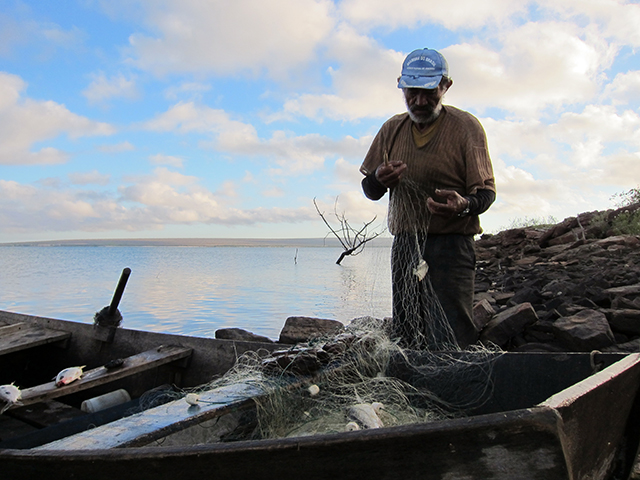 A fisherman returns in the evening to one of the islands in the lake for dinner and sleep after casting nets into the waters to be collected in the morning. (Photo: Renata Bessi)
A fisherman returns in the evening to one of the islands in the lake for dinner and sleep after casting nets into the waters to be collected in the morning. (Photo: Renata Bessi)
It’s 5 o’clock in the morning on one of the islands in Lake Itaparica, the fishermen call Port Serra do Mocó. Rosalvo Ferreira da Silva arrives in his canoe with the net that had been left in the water at the end of the previous day. To cast the net into the river, it’s ideal for there to be at least two people, one to hold onto the boat, and the other to cast the net. But Rosalvo goes out alone. “The wind raises up the boat while I work with the net. If it carries me in the wrong direction I get angry.” In the net, tilapia, corvine, and piava can be seen. The canoe reaches the shore, and he begins to prepare the fish.
Rosalvo, who is 64, is from the town of Old Barrier, which is now under the dam’s waters. He started fishing when he was 12, but after the construction of the dam and the flooding of his town, he moved to Petrolandia.
How the fishermen use the San Francisco River goes beyond just providing for their families; a mystical, ancestral relationship exists.
As he cuts open the fish, the fisherman shares that the fishing that day wasn’t very good. “The moon is brilliant [full]. To fish with bait, it doesn’t matter if the moon is bright or dark. But for net fishing, the light from the full moon doesn’t help because it reflects off the net and scares the fish,” Rosalvo explains.
Rosalvo enjoys the solitude of the water. He feels protected. “I don’t know about you, but during those six hours, I see Mary of the Waters. I am alone and focused. I know people who also see her. The water of the rivers has a lot of secrets, like the stars in the sky and like the forest.”
How the fishermen use the San Francisco River goes beyond just providing for their families; a mystical ancestral relationship exists. “The relationship between these communities and the river itself is presented as something so intimate that it sounds like a familial relationship. The river, with its myths, its waters and its cycles, becomes a part of the way of being of the people,” Neusa Francisca Nacimiento, of the CPP in Minas Gerais, tells Truthout.
Common knowledge of the water, the fish, the weather, the stars, is established across generations. This knowledge is engendered in the communities’ collective and is not learned in school; it is passed from parent to child. Its practitioners want to defend this kind of life built around fishing, and they are currently developing efforts for the regularization of recognition of traditional fishing communities’ territory.
What exists in this country is a development model that doesn’t include the Brazilian people.
The fishermen and women’s movement is creating a campaign to take advantage of the law that guarantees land to traditional fishing communities, through a popular initiative. “Today the channels for the regularization of the territories of traditional fishing communities do not exist,” explains María José. The goal, according to her, is to regularize the areas used by the fishermen, just as other lands are demarcated for indigenous and Afro-Brazilian communities. To be approved, the bill would need the support of 1 percent of the Brazilian electorate, which is to say 1,406,466 signatures.
Threats
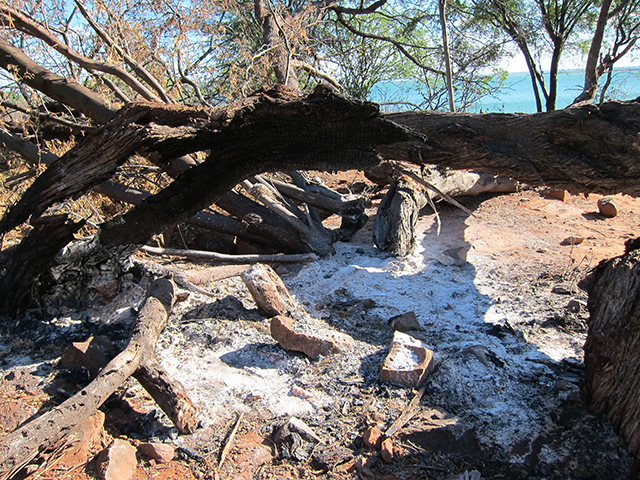 Employees of AAT International Ltd., a Brazilian aquaculture company, were sent to destroy this “ranch,” a place where fishermen traditionally gathered. (Photo: Renata Bessi)
Employees of AAT International Ltd., a Brazilian aquaculture company, were sent to destroy this “ranch,” a place where fishermen traditionally gathered. (Photo: Renata Bessi)
Fishing is a millennia-old activity in Brazil. Proof of this abounds in the sambaquis (which comes from the Tupi language, meaning “shell mound”). They are piles of shells and other kitchen utensils at archaeological sites along the Brazilian coast that date from over 8,000 years ago. Tarcisio Quinamo, a researcher with the Joaquim Nabucco Foundation (Fundaj) says, “Small-scale fishing is maintained, of course, with modern developments. And the threats have never been more alive.”
For María José, what exists in this country is a development model that doesn’t include the Brazilian people. “The territories that we fish in are beautiful, valuable, and full of water, forests, and mangroves. Because of this, these lands are being disputed. But these areas only exist because these communities have preserved them,” she says.
“What in the world is this development that destroys homes, that forces people who don’t have money out of where they live? It takes the will of the people, the law, and desire [to change it],” says María das Neves.
Translated by Miriam Taylor